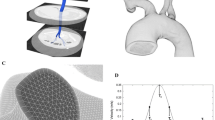Abstract
Two sets of geometric models were developed for the hemodynamic study of the thoracic aorta (with and without aneurysm): one patient-specific, built from computed tomography and another idealized, constructed in CAD software. The boundary conditions were established by a velocity pulse at the inlet of the thoracic aorta and a pressure pulse at the aorta outlets of an adult, normotensive, and resting subject. The CAD model for the healthy aorta closely approximates the patient-specific one; especially during the systolic peak with maximum percentage difference of 3.2 and 4.6% for, respectively, the pressure and velocity fields. The CAD—constructed aneurysm model, with 60% permanent diametric dilatation, is close to the minimum medical definition of an aortic aneurysm, which allowed the investigation of the minimal physiological changes that an aneurysm brings to the blood flow. Despite the striking difference in size in relation to the aneurysm of the patient-specific model, it was found that in most cases, the physical phenomena were similar in both models.







Similar content being viewed by others
References
Bonamigo TP, Siqueira I (2003) Screening for abdominal aortic aneurysms. Rev Hosp Clín 58(2):63
Barros FS, Pontes SM, Taylor MAS et al (2005) Rastreamento do aneurisma da aorta abdominal na população da cidade de Vitória (ES). J Vasc Br 4:59
Puech-Leão P, Molnar LJ, de Oliveira IR, Cerri GG (2004) Prevalence of abdominal aortic aneurysms: a screening program in São Paulo, Brazil, Sao Paulo. Med J 122(4):158
Augusto Hasiak Santo MK, Puech-Leão P (2012) Trends in aortic aneurysm- and dissection-related mortality in the state of S+úo Paulo, Brazil, 1985–2009: multiple-cause-of-death analysis. BMC Public Health. doi:10.1186/1471-2458-12-859
Clouse W, Hallett J Jr, Schaff H, Gayari M, Ilstrup D, Melton IL (1998) Improved prognosis of thoracic aortic aneurysms: a population-based study. JAMA 280(22):1926
Davis FM, Rateri DL, Daugherty A (2014) Mechanisms of aortic aneurysm formation: translating preclinical studies into clinical therapies. Heart (British Cardiac Society) 100(19):1498. doi:10.1136/heartjnl-2014-305648
Bourantas GC, Skouras ED, Loukopoulos VC, Burganos VN, Nikiforidis GC (2011) [IEEE 2011 10th International Workshop on Biomedical Engineering - Kos, Greece (2011.10.5–2011.10.7)] 2011 10th International Workshop on Biomedical Engineering - Two-phase blood flow modeling and mass transport in the human aorta. doi:10.1109/iwbe.2011.6079066
Liu X, Fan Y, Deng X, Zhan F (2011) Effect of non-Newtonian and pulsatile blood flow on mass transport in the human aorta. J Biomech. doi:10.1016/j.jbiomech.2011.01.024
Shipkowitz T, Rodgers V, Frazin LJ, Chandran K (2000) Numerical study on the effect of secondary flow in the human aorta on local shear stresses in abdominal aortic branches. J Biomech. doi:10.1016/s0021-9290(99)00223-7
Khani S, Atefi G, Soleimani A (2011) Simulation of flow field for pulsatile blood flow in a femoral artery based on cosserat continua. J Dispers Sci Technol. doi:10.1080/01932691.2010.505110
Caballero A, Laín S (2015) Numerical simulation of non-Newtonian blood flow dynamics in human thoracic aorta. Comput Methods Biomech Biomed Eng. doi:10.1080/10255842.2014.887698
Eeg TB (2012) Fluid structure interaction simulation on an idealized aortic arch. Master’s Thesis, Fluid Structure Interaction Simulation on an Idealized Aortic Arch, Norwegian University of Science and Technology
Johnston K, Rutherford RB, Tilson M, Shah DM, Hollier L, Stanley JC (1991) Suggested standards for reporting on arterial aneurysms. J Vasc Surg. doi:10.1067/mva.1991.26737
Celik IB, Ghia U, Roache PJ (2008) Procedure for estimation and reporting of uncertainty due to discretization in CFD applications. J Fluids Eng. doi:10.1115/1.2960953
Prakash S, Ethier CR (2001) Requirements for mesh resolution in 3D computational hemodynamics. J Biomech Eng. doi:10.1115/1.1351807
Wilcox D (1986) American Institute of Aeronautics and Astronautics 24th Aerospace Sciences Meeting—Reno, NV, USA, 24th Aerospace Sciences Meeting—multiscale model for turbulent flows. doi:10.2514/6.1986-29
Banerjee RK, Cho YI, Kensey KR (1998) A study of local hydrodynamics in a 90\(^{\circ }\) branched vessel with extreme pulsatile flows. Int J Comput Fluid Dyn 9(1):23. doi:10.1080/10618569808940838
Cho YI, Kensey KR (1991) Effects of the non-Newtonian viscosity of blood on flows in a diseased arterial vessel. Part 1: Steady flows. Biorheology 28(3–4):241–262
Gijsen FJ, van de Vosse FN, Janssen J (1999) The influence of the non-Newtonian properties of blood on the flow in large arteries: steady flow in a carotid bifurcation model. J Biomech 32(6):601
Lucas TC, Tessarolo F, Jakitsch V, Caola I, Brunori G, Nollo G, Huebner R (2014) Blood flow in hemodialysis catheters: a numerical simulation and microscopic analysis of in vivo-formed fibrin. Artif Organs 38(7):556
Reymond P, Crosetto P, Deparis S, Quarteroni A, Stergiopulos N (2013) Physiological simulation of blood flow in the aorta: comparison of hemodynamic indices as predicted by 3-D FSI, 3-D rigid wall and 1-D models. Med Eng Phys 35(6):784. doi:10.1016/j.medengphy.2012.08.009
Ouared R, Chopard B (2005) Lattice Boltzmann simulations of blood flow: non-Newtonian rheology and clotting processes. J Stat Phys 121(1):209
Acknowledgements
The authors gratefully acknowledge CAPES for the masters scholarship granted.
Author information
Authors and Affiliations
Corresponding author
Additional information
Technical Editor: Francisco Ricardo Cunha.
Rights and permissions
About this article
Cite this article
Silveira, M., Huebner, R. & Navarro, T.P. Pulsatile blood flow in the thoracic aorta and aneurysm: a numerical simulation in CAD-built and patient-specific model. J Braz. Soc. Mech. Sci. Eng. 39, 3721–3728 (2017). https://doi.org/10.1007/s40430-017-0837-2
Received:
Accepted:
Published:
Issue Date:
DOI: https://doi.org/10.1007/s40430-017-0837-2




